NEET Biology Organisms And Population Ageing And Death
NEET Biology Organisms And Population Ageing And Death Growth
- Growth: It refers to the augmentation in size and mass of an organism resulting from the synthesis of protoplasmic and apoplastic components. The event occurs when anabolism predominates in the overall metabolic process. There are three types of growth.
- Auxetic growth: In this instance, the volume of the organism expands due to the proliferation of body cells without an increase in the number of cells. The quantity of cells is predetermined in the majority of bodily regions. This sort of growth occurs in worms, rotifers, and a category of early chordates known as tunicates.
- Multiplicative growth :In this scenario, the cell count grows while the average cell size remains constant. All occurring decisions are mitotic. It frequently manifests in embryos and is a defining feature of the prenatal development of higher vertebrates.
- Accretionary growth refers to the mitotic division of reserve cells to augment and substitute the depleted differentiated cells.
- The various cells in the post-embryonic phase lose their ability to divide, resulting in this form of growth, for example. Development of epidermal cells from the Malpighian layer.
- Appositional growth: it entails the accumulation of new layers onto already established layers. It is a distinctive way of growth for stiff materials.
Read and Learn More NEET Biology Notes
NEET Biology Organisms And Population Ageing And Death Growth Rate
All creatures develop at a certain rate and cadence. The growth is a noticeable and quantifiable increase in the bulk of living material, which can be assessed by weighing at intervals.
Furthermore, the growth rate is variable, as organisms develop at distinct rates throughout different intervals. Rapid growth occurs throughout prenatal and teenage stages, which then decelerates during juvenile and post-adolescent phases, ultimately ceasing thereafter.
NEET Biology Organisms And Population
NEET Biology Organisms And Population Ageing And Death Growth Curve
The growth of an animal organ for a definite period when plotted against time forms a S-shaped Sigmoid curve. it is called a growth curve.
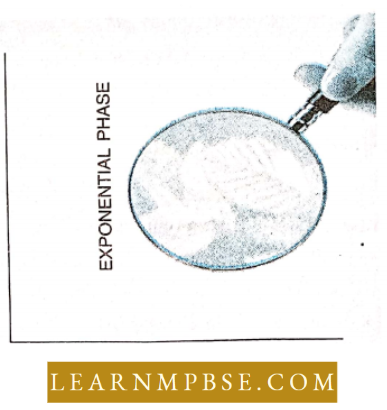
- An analysis of the Sigmoul curve shows ills’ glow it is slow in llu[•Birds and mammals stop growing when they have attained a certain characteristic age and size.
- it has been found that the factors that check the unlimited growth of animal tissues are many and varied. One such mechanism is the intrinsic antagonism between the factors that regulate the process of proliferation.
- The initial and final weight of an individual for any period of tune is lowed absolute prow lit. l.i Cell uniw3 Grow the old cells’ events during the inter of the cell cycle.
- During this phase, new materials such as nucleic acids, proteins, and protoplasmic bodies were formed. interphase is completed in three phases G, S and G, phases. Cell growth is an utmost important factor in the growth of multicellular animals. Cell growth leads to the division of cells also. Cell growth cannot be measured because of the small size and location of the cell.
1. Pattern Of Growth:
- Isometric growth: in this pattern of growth, an organ grows at the same mean rate as the rest of the body c.y. fishes and certain insects like locusts.
- Allnnictric growth: in this pattern of growth, an organ grows at a rate different from that at which the body grows mammals.
2. Methods Of Growth: Growth in animals is accomplished by several methods.
The most important of these are:
- Protoplasmic synthesis: Through this process, the growing animal synthesizes new l4ing matter from available food materials. The new raw materials are obtained from the digestion and absorption of complex food materials such as proteins, carbohydrates and lipids.
- Uptake of water: The amount of water that accumulates in the animal body during growth and development is enormous.
- intercellular deposition; Large-scale intercellular deposition of non-living matter occurs during growth. These substances consist mostly of jelly, fibres or the ground substances of cartilage and bone.
NEET Biology Organisms And Population
NEET Biology Organisms And Population Ageing And Death Hormonal Control Of Growth Rate in Man
- Thymosin hormone, released by the thymus gland, affects growth during the ages of 10 to 13 years (childhood).
- This era is characterized by sluggishness. Thyroxine and somatotropic hormone (STH) enhance development rate throughout late childhood.
- Growth accelerates throughout puberty (ages 14 to 18 years) due to heightened secretory activity of the pituitary and other endocrine glands.
- In males, testosterone regulates the development of secondary sexual organs and accessory sex traits, whereas in females, progesterone and estrogen perform similar functions.
NEET Biology Organisms And Population Ageing And Death Growth Factors
- Epidermal Growth Factor (EGF): it stimulates epithelium to undergo mitosis – EGF is produced under the scab and is also produced in the sal4ary glands.
- Fibroblast growth Factor (FGF): it stimulates the division of endothelial cells to heal the injured blood vessels.
- Platelet-der4ed Growth Factor (PGF): it stimulates the mitosis of fibroblasts at the injured site to fill in the damaged area under the blood clot.
Measurement of Growth
- The amount of growth, an animal undergoes is expressed in terms of absolute growth or relative growth.
- The absolute growth rate is the increase in growth per unit of time.
- The relative growth rate is a relative increase in growth per unit of time. Comparisons of relative growth rates show many interesting patterns in animal growth.
Grow th Arresting Factors
- Birds and mammals stop growing when they have attained a certain characteristic age and size.
- it has been found that the factors that check the unlimited growth of animal tissues are many and varied. One such mechanism is the intrinsic antagonism between the factors that regulate the proliferation process.
- Another check on growth is cell destruction. Another mechanism is the hormonal cessation of growth in the long hones.
NEET Biology Organisms And Population Ageing And Death Regeneration
Regeneration, The ability of a living organism to replace out parts, regrow cast tY organs and transform the entire body from small fragments of it is called regeneration.
Categories of animal regeneration :
- Restorative regeneration.
- Restorative regeneration.
1. Restorative regeneration: It is a common phenomenon amongst invertebrates and vertebrates. in sponges, an entire sponge may regenerate and form a group of a few cells. Similarly in Hydra, small pieces containing both germ layers may regenerate into new organisms.
Different Animal groups and their Regenerative body parts
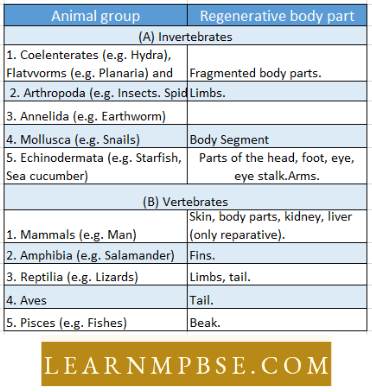
Organisms And Population MCQs NEET
2. Reparative regeneration: It is quite common in the case of invertebrates and vertebrates. Amongst vertebrates, it is best observed in the Axolotl larva which can replace its tail, limbs and eyes. Tadpole the frog also shows a similar type of regeneration. Lizards can regenerate their tails but they are without bones. L4er in man has great power of reparative regeneration.
- Physiological regeneration: Replacement of cells of the body which are worn out due to constant activities.
- Compensatory hypertrophy: The regeneration of internal organs by enlarging one of the paired organs in case one is lost accidentally e.g. kidney
- Heleromorphosis: Regeneration that produces a part different from a lost part, e.g. crayfish.
- Mechanism of regeneration: given by T.H. Morgan
- Morphallaxis: It is the reconstruction of an entire animal from a small fragment by reorganization of the existing cells.
- Epimorphosis: It replaces a lost organ of the body by the proliferation of new cells from the surface of the injured part.
NEET Biology Organisms And Population Ageing And Death Ageing
- Gerontology: The field of developmental biology which deals with the study of the process of ageing is known as gerontology. it is the progress or deterioration in the structure and functions of cells, tissues and organs of the organism with time. it leads to death.
- Ageing: it is progress4e deterioration in this structure ami functions of cells, tissues, of pans ami organ systems. There is a progress decline in metabolism’s ability to replace worn-out cells, repair damaged tissues and resistance to diseases.
As old age progresses, skin becomes dry, and wrinkled, hair falls off, the body assumes a stooping posture, bones become brittle, and muscles, skin and cartilage become less elastic. Ageing affects the blood-vascular system. Sense organs like an ear. eyes etc. lose their intensities and kidney tubules are no more efficient
in the production of normal urine.
- The heart pumps 35% less blood and sends 20% and 58% less blood to the brain and kidneys.
- Oxygen carrying capacity of blood reduces.
- The formation of new RBCs from the bone marrow slows down.
- Calcium accumulates in the blood.
Cellular changes during ageing
- There occurs reduction in tbe granular endoplasmic reticulum, partial degeneration of mitochondria (According to Rafsksy and Brarrows i958) and accumulation of lipofuscin granules.
- Somatic mutations occur in, tbe cells of l4er, brain, heart and stomach.
- Certain enzymes like aldolase, acctyl-cholincstrase, lactase dehydrogenase, glucose 6- phosphate dehydrogenase show reduced act4ities.
- The number of chromosomes changes from the normal. Thus there are changes in DNA structure. in mice, dog and man, with increase in age, the l4er cells exhibit increased number of chromosomal aberrations,
- Cellular membranes come to have calcium deposition, (According to Shock and Strehler i962) thus do not show select4e permeability.
- Due to storage of certain pigments, the rate of cell d4ision decreases.
Extracellular changes: Extracellular changes include structural and functional changes in collagen.Collagen is most abundant extracellular protein which with ageing becomes less permeable, less flexible and insoluble. These changes interfere the normal functioning of the cells and induce the ageing.
Changes at the organ level include structural changes in the skin, muscles, bones etc. and also physiological changes in the vital organs like the heart, brain, kidney etc
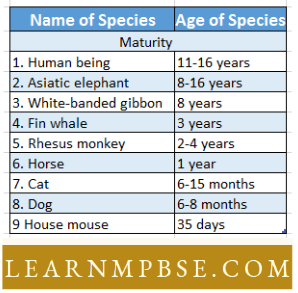
NEET Biology Organisms And Population Ageing And Death Theories Of Ageing
- The exact reason behind ageing is not clearly understood, and it is considered a cyclic phenomenon in one’s life. Several hypotheses have been proposed to explain the reason for ageing. They are as follows :
- According to one view, free radicals accumulate with age which brings about oxidant reactions resulting in the deterioration of collagen and elastin etc. The oxidation of unsaturated fats results in the impairment of cell membranes in their select4e permeability.
- The immunity system breaks down since the capacity of the formation of lymphocytes by bone marrow is lessened.
- Ageing reduces the sensibility and effectiveness of the nervous control over the endocrine glands.
- The high rate of metabolism results quickening of old age. probably CrT in,hc coded message of DNA increases due to old age which affects proper protein synthesis.
- The tendency of ageing is intrinsic i.c. an organism will undergo ageing at a rat determined by the nature of genes.
Whatever views have been proposed, even today the understanding of the reasons for old age remains vague.
Organisms And Population MCQs NEET
Degrowth and death factors which result in degrowth
- The rate of breakdown surpasses that of synthesis reactions within the body.
- Internal reserves, shown as fat in adipose tissue, are metabolized to supply energy for essential living functions.
- Proteins from the living materials are also utilized for energy production.
- All these variables contribute to the depletion of living matter and lead to degrowth.
- Lipofuscin is the pigment associated with aging.
- With aging, there is a decrease in body weight by 12%, brain weight by 15%, and liver weight by 37%.
- The basal metabolic rate is 20%, the speed of nerve impulses is 5%, and the renal blood flow is 40%. to the brain is 80%. Consequently, there are few lymphocytes.
NEET Biology Organisms And Population Ageing And Death Death
it is a biological event which is due to a permanent breakdown in body functioning usually occurring due to a lack of oxygen supply to tissues. The cells stop normal functioning. it is an inescapable event of life.
Symptoms of clinical death: Symptoms of clinical death are Heartbeat, pulse and respiration stop 2 Pupils become fixed, remain dilated and do not respond to light.
Two main categories of causes of death
- Weakening of tissues and vital organs: Weakening of tissues and vital organs, such as the heart, liver, kidney etc. result in physiological and metabolic disorders of irreversible nature. Sudden blockage of blood supply to the heart, and brain causes instantaneous death.
- Due to ageing, there is a gradual breakdown in the immune system. Thus due to loss of body resistance, in old age man becomes susceptible to infectious diseases.
- Considerable growth occurs during the late embryonic or foetal period in the case of mammals.
- Replacement of old worn-out cells, metamorphosis and regeneration are the three main categories of post-embryonic development.
- Post-embryonic developments are characterised by growth, morphogenesis and differentiation finally. Ageing is also a post-embryonic stage.
- Animals grow at different rates at different periods of life.
- The human embryo is i50 /rm at the time of implantation and grows to about 50 cm during the gestation period.
- Growth may be auxetic or multiplicat4e accretionary. Fibroblast growth factors (FGFs) control cell proliferation in the development of limbs in chick, and insulin-like growth factors (iGFs) have a role in prenatal and postnatal growth of mammals. Growth hormone (Gil) secreted in the anterior lobe of the pituitary plays an important role in growth during childhood.
- Hydra and planaria have a capacity for regeneration. Nematodes show very low regenerat4e ability.
- Glial growth factors (GGFs) and other factors such as (FGFs iGFs) control amphibian limb regeneration.
- Compensatory regeneration: In the case of compensatory regeneration, the cells of l4er or kidney d4ide do not form an undifferentiated mass of cells or tissues, rather produce cells similar to themselves and maintain their function.
- Epimorphic regeneration: In the case of epimorphic regeneration as in Salamander, dedifferentiation occurs, and then these cells divide to form blastema which later on transforms into a correctly patterned limb structure.
- Reparative regeneration: The power of repairing only some body cells e.g. skin layer: gut lining: RBCs of blood etc.
- Morphallactic regeneration: The formation of the whole body from a body fragment by reorganizing the existing cells, e.g. Formation of components body of Hydra from a fragment.
NEET Biology Important Notes PDF
Changes in the weights of human body parts from birth to adulthood:

Life Span Of Selected Animals:

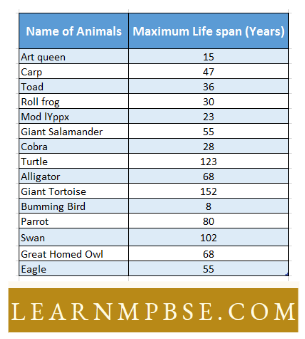
NEET Biology Organisms And Population Ageing And Death Quanta To Memory
- Vladimir Korenchevsky-Father of gerontology
- Werner Syndrome is a syndrome with signs of advanced ageing in the 20s.
- Eutyly: When the number of cells is constant both for the entire life and specific organs e.g. Ascaris.
- Nucleopycnosis: It is the shrinkage and condensation of chromatin leading to the death of the nucleus.
- Heteromorpliosis: it is a case when the regenerated part is different from the lost part.
- There are 60 quadrillion cells in an average adult human body weighing 60 kg but only 2 quadrillion in an infant.
From the age of about 30 years, the human body becomes functionally less efficient by about 0.8% every year. - The nucleus shrinks and stains deeply with advancing age. This is due to condensation of chromatin and leads to cellular death. Such a degenerat4e process is called nuclear pyknosis
- By the age of 75 years, the number of uriniferous tubules is reduced to half in men.
Japanese have the highest life expectancy limit. The average life of a Japanese woman is 8i.5 years while that of a man is 76.2 years Regeneration was discovered by Trembley in Hydra. - When reserve food material is utilised in the body, the process is called degrowth.
- in ascidian tadpole Example larva of Herdmcmia) there occurs retrogress4e metamorphosis.
- Maximum power of autotomy (self-mutilation) is found in holothurians (echinoderms). These organisms can throw off their internal visceral organs whenever threatened by a predator. in mammals, external body parts are not regenerated.
- But mammals have a great capacity to regenerate some of the internal organs. L4er has the maximum capacity of regeneration. Similarly, if one kidney is removed, the other enlarges and takes over the function of the lost kidney. Such a reparat4e regeneration is known as compensatory hypertrophy.
NEET Biology Organisms And Population Ageing And Death Questions
Question 1. Which one of the following is (rue during ageing?
- Decrease in blood urea and GFR
- increase in calcium content of arteries and cartilage
- Decrease in cholesterol content of cornea and lens
- Decrease in calcium content of arteries and cartilage.
Answer: 2. increase in calcium content of arteries and cartilage
Population Ageing And Death NEET Biology Notes
Question 2. in human beings the growth in height becomes nearly constant after the age of:
- 15 years
- 20 years
- 30 years
- 40 years.
Answer: 2. 20 years
Question 3. Which one of the following statements is correct concerning a test tube baby?
- Fertilization of the egg is affected outside the body; the fertilized egg is then placed in the womb of the mother where the gestation is completed
- Fertilization of the egg and growth of the embryo arc affected in a large test tube
- A prematurely born baby reared in an incubator
- Fertilization of the egg is affected in the female
- Genital tract; the fertilized egg is then taken out and grown in a large test tube.
Answer: 1. Fertilization of the egg is affected outside the body; the fertilized egg is then placed in the womb of the mother where the gestation is completed
Question 4. The science of ageing is called :
- Chronology
- Odontology
- Gynaecology
- Gerontology.
Answer: 4. Gerontology.
Question 5. Ageing in many mammals including man may be due to:
- Adverse changes in the environment
- interaction between hereditary factors
- Malnutrition and stress
- All of the above.
Answer: 4. All of the above.
Question 6.Degenerat4e changes occur during :
- Metamorphosis only
- Parthenogenesis
- Ageing only
- Both in metamorphosis and ageing.
Answer: 4. Both in metamorphosis and ageing.
Question 7. As a person becomes old, a degenerat4e process sets in the body which causes:
- A gradual alteration in the connect4e tissue components only
- Increases the collagen content of the connect4e tissues
- And increases the mucopolysaccharides content of most of the connective tissue.
- Both in metamorphosis and ageing.
Answer: 4. Both in metamorphosis and ageing.
NEET Biology Important Notes PDF
Question 8. The growth in an animal includes:
- increase in size
- increase in weight
- Synthesis of new proteins
- All.
Answer: 4. All.
Question 9. The growth rate in most of the animals is:
- Sigmoid for all organs
- Linear for all organs
- Uniform for all organs
- Different for different organs.
Answer: 4. Different for different organs.
Question 10. The pigment of ageing is:
- Haemoglobin
- Hacmocyanin
- Melanin
- Lipofuscin.
Answer: 4. Lipofuscin.
Question 11. With the advancement of age, the hair of males starts thinning due to :
- Falling of hair
- Low ATP formation
- Reduced rate of protein synthesis
- None of the above.
Answer: 3. Reduced rate of protein synthesis
Question 12. The most accepted theory of ageing is :
- Death of brain cells
- Non-functioning of a – cells in the pancreas
- Less RBC in blood
- Non-functioning of thymus gland.
Answer: 4. Non-functioning of thymus gland.
Question 13. The growth rate in childhood is controlled by :
- Thymosine
- Thyroxine
- Oestrogen
- Progesterone
- Testosterone.
Answer: 1. Thymosine
Question 14. Which is not connected with the theory of ageing?
- Wear and tear
- Neurohormonal changes
- Epimorphosis
- Metabolic rate
- Somatic mutation.
Answer: 3. Epimorphosis
Question 15. Growth is an irreversible process found at :
- Subcellular growth
- Cellular growth
- Organ growth
- All of the above.
Answer: 4. All of the above.
Ecology Class 12 NEET Notes
Question 16. In animals, chalones are substances responsible for:
- Regeneration
- Ageing
- Development
- Parthenogenesis.
Answer: 2. Ageing
Question 17. Growth in l4ing being is called :
- Accretion
- intussusception
- Aggregation
- interaction.
- Accumulation.
Answer: 1. Accretion
Question 18. if Hydra is broken into pieces:
- Hydra will die
- Hydra will undergo sexual reproduction
- Some fragments will form a complete Hydra
- Every fragment will grow into a complete Hydra
Answer: 4. Every fragment will grow into a complete Hydra
Question 19. Formation of the whole body from a fragment is:
- Cpimorphosis
- Morphallaxis
- Epigenesis
- Auxetic growth.
Answer: 2. Morphallaxis
Question 20. The correct sequence of growth curve for bacteria is:
- Lag. log, stationary’ and decline
- Lag. log, decline and stationery
- Stationary, lag. log, decline
- Decline, lag and log phase.
Answer: 2. Lag. log, decline and stationery
Question 21. Semilog of per minute growing bacteria is plotted against time. What will be the shape of the graph?
- Ascending straight line
- Sigmoid
- Hyperbolic
- Descending straight line.
Answer: 1. Ascending straight line
Question 22. Senescence is inhibited by :
- Ethylene
- Gibberellic acid
- Cytokinin
- Abscisic acid.
Answer: 3. Cytokinin
Question 23. In which phase proteins for spindle Fibre formation are synthesized?
- G-phase
- G-phase
- S-phase
- Anaphase.
Answer: 3. G-phase
Question 24. The maximum life span of a dog in years is :
- 5
- 10
- 15
- 20.
Answer: 4. 20
Ecology Class 12 NEET Notes
Question 25. In the somatic cell cycle :
- In Gjphase DNA content is double the amount of DNA present in the original cell
- DNA replication takes place in S-phase
- A short interphase is followed by a long mitotic
- Phase.
Answer: 2. DNA replication takes place in S-phase
Question 26. The maximum growth rate occurs in :
- Senescent phase
- Stationary phase
- Lag phase
- Exponential phase.
Answer: 4. Exponential phase.
Question 27. Four healthy people in their twenties got involved in injuries resulting in damage and death of a few cells of the following. Which of the cells are least likely to be replaced by l4ing cells?
- Osteocytes
- Malpighian layer of skin
- Liver cells
- Neurons.
Answer: 4. Neurons.
Question 28. Based on cellular mechanisms there are two major types of regeneration found in the animals. Which of the following is the correct example of the type mentioned?
- Morphallaxis- Regeneration of two transversely cut equal pieces of a Hydra into two small Hy draws.
- Epimoiphosis – Replacement of old and dead erythrocytes with new ones.
- Morphallaxis – Healing up of a wound in the skin.
- Epimorphosis – Regeneration of crushed and filtered out pieces of a Planaria into as many new Planar- cans.
Answer: 1. Morphallaxis- Regeneration of two transversely cut equal pieces of a Hydra into two small Hy dras.
Question 29. Ageing of an animal’s body is associated with deterioration in its :
- Connect4e tissue
- Glandular tissue
- Epithelial tissue
- Both 1 and 2.
Answer: 2. Glandular tissue
Question 30. The modern idea about ageing is that our body slowly loses the power of defence against the invasion of germs and pathogens, this process starts with the
the disappearance of which organ?
- Spleen
- Thymus gland
- Pituitary gland
- Parathyroid gland.
Answer: 2. Thymus gland
Question 31. Match the items in Column I with Column II and choose the correct alternatives :
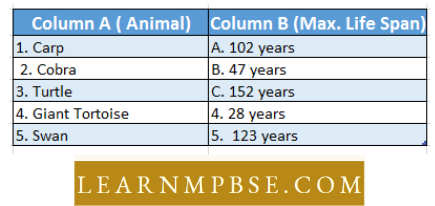
- 1 = A 2= D, 3 = C, 4= E, 5 =B
- 1 = B, 2 = C, 3 = D, 4 = E, 5 = A
- 1 = B, 2 = D, 3= E, 4= C. 5 = A
- 1 = A, 2= C, 3= B, 4 = B, 5=D
- 1 = C, 2 = D, 3 = E, 4 = B, 5 = A
Answer: 1. 1 = A ,2= D, 3 = C, 4= E, 5 =B
Question 32. Which endocrine gland becomes inactive in old age?
- Adrenal
- Thyroid
- Thymus
- Pituitary.
Answer: 3. Thymus
Ecology Class 12 NEET Notes
NEET Biology Organisms And Population Ageing And Death Self Assessment Test Unit Reproduction
Question 1. A low statements describing certain features of reproduction are given below :
1. Gametic fusion takes place
2. Transfer of genetic material takes place
3. Reduction division takes place
4. Progeny has some resemblance with parents Select the options that are true for both asexual and sexual reproduction from the options given blow:
- 1 and 3
- 2 and 3
- 2 and 4
- 1 and 3
Answer: 3. 2 and 4
Question 2. The term ‘clone cannot be applied to offspring formed by sexual reproduction because :
- Offspring do not possess exact copies of parental DNA.
- DNA of only one parent is copied and passed on to the offspring
- Offspring are formed at different times
- DNA of parent and offspring are completely different.
Answer: Offspring do not possess exact copies of parental DNA.
Question 3. Amoeba and Yeast reproduce asexually by fission and budding respectively, because they are :
- Microscopic organisms
- Heterotrophic organisms
- Unicellular organisms
- Uninucleate organisms
Answer: 3. Unicellular organisms
Question 4. A few statements about sexual reproduction are given below :
- Sexual reproduction does not always require two individuals
- Sexual reproduction generally involves gametic fusion.
- Meiosis never occurs during sexual reproduction
- External fertilisation is a rule during sexual reproduction.
Choose the correct statements from the options below :
- 1 and 4
- 1 and 2
- 2 and 3
- 1 and 4
Answer: 2. 1 and 2
Question 5. A multicellular, filamentous alga exhibits a type of sexual life cycle in which the meiotic division occurs after zygote formation. The adult filament of this alga has
- Haploid vegetative cells and diploid gametangia
- Diploid vegetative cells and diploid gametangia
- Diploid vegetative cells and haploid gametangia
- Haploid vegetative cells and haploid gametangia
Answer: 4. Haploid vegetative cells and haploid gametangia
NEET Biology Organisms And Population
Question 6. The male gametes of rice plants have i2 chromosomes in their nucleus. The chromosome number in the female gamete, zygote and the cells of the seedling will be respectively.
- 12, 24. 12
- 24, 12, 12
- 12. 24.24
- 24, 12. 24
Answer: 3. 12. 24.24
Question 7. Given below are a few statements related to external fertilization. Choose the correct statements.
1. The male and female gametes arc formed an<i released simultaneously
2. Only a few gametes are released into the medium.
3. Water is the medium in a majority of organisms exhibiting external fertilization.
4. Offspring formed as a result of external fertilization have a better chance of survival than those formed inside an organism
- 3 and 4
- 1 and 3
- 2 and 4
- 1 and 4
Answer: 2. 1 and 3
Question 8. The statements given below describe certain features that are observed in the pistil of flowers.
1. Pistil may have many carpels
2. Each carpel may have more than one ovule
3. Each carpel has only one ovule
4. Pistil has only one carpel
Choose the statements that are true from the options below :
- 1 and 2
- 1 and 3
- 2 and 4
- 3 and 4
Answer: 1. 1 and 2
Question 9. Which of the following situations correctly describes the similarity between an angiosperm egg and a human egg?
- Eggs of both are formed only once in a lifetime
- Both the angiosperm egg and the human egg are stationary
- Both the angiosperm egg and human egg are motile and transported
- Syngamy in both results in the formation of zygote
Choose the correct answer from the options given below:
- 2 and 4
- 1 and 4
- 3 and 4
- 1 and 4
Answer: 2. 1 and 4
Question 10. The appearance of vegetat4e propagules from the nodes of plants such as sugarcane and ginger is mainly because:
- Nodes are shorter than int models
- Nodes have meristematic cells
- Nodes are located near the soil
- Nodes have non-photosynthetic cells
Answer: 2. Nodes have meristematic cells
Question 11. Which of the following statements, supports the view that elaborate sexual reproduction process appeared much later in the organic evolution?
1. Lower groups of organisms have a simpler body design
2. Asexual reproduction is common in lower groups
3. Asexual reproduction is common in higher groups of organisms
4. The high incidence of sexual reproduction in angiosperms and vertebrates.
Choose the correct answer from the options given below:
- 1 and 2
- 1 and 3
- 2 and 4
- 2 and 3
Answer: 3. 2 and 4
NEET Biology Organisms And Population
Question 12. Offspring formed by sexual reproduction exhibit more variation than those formed by asexual reproduction because:
- Sexual reproduction is a lengthy process
- Gametes of parents have qualitat4ely different genetic composition
- Genetic material comes from parents of two different species
- The greater amount of DNA is involved in sexual reproduction.
Answer: 3. Gametes of parents have qualitat4ely different genetic composition
Question 13. Choose the correct statement from among the following:
- Dioecious (hermaphrodite) organisms are seen only in animals
- Dioccies organisms are seen only in plants
- Dioecious organisms are seen in both plants and animals
- Dioecious organisms are seen only in vertebrates.
Answer: 4. Dioecious organisms are seen only in vertebrates.
Question 14. There is no natural death in single-celled organisms like Amoeba and bacteria because :
- They cannot reproduce sexually
- They reproduce by binary fission
- The parental body is distributed among the offspring
- They are microscopic
Answer: 2. They reproduce by binary fission
Question 15. There are various types of reproduction. The type of reproduction adopted by an organism depends on :
- The habitat and morphology of the organism
- Morphology of the organism
- Morphology and physiology of the organisms
- The organism’s habitat, physiology and genetic makeup
Answer: 1. The habitat and morphology of the organism
Question 16. Identify the incorrect statement.
- In asexual reproduction, the offspring produced are morphologically and genetically identical to the parent
- Zoospores are sexual reproduct4e structures
- In asexual reproduction, a single parent produces offspring with or without the formation of gametes
- Conidia are asexual structures in the Penicillium
Answer: 4. Conidia are asexual structures in Penicillium
Question 17. Which of the following is a post-fertilisation event in flowering plants?
- Transfer of pollen grains
- Embryo development
- Formation of flower
- Formation of pollen grains
Answer: 4. Formation of pollen grains
Question 18. The number of chromosomes in the shoot tip cells of a maize plant is shall be :
- 20
- 10
- 40
- 15
Answer: 3. 40
Question 19. Among the terms listed below those that are not correct names for a floral whorl are :
- Androecium
- Carpel
- Corolla
- Sepal
- 1 and 4
- 3 and 4
- 2 and 4
- 1 and 3
Answer: 3. 2 and 4
Question 20. The embryo sac is to ovule as is to an anther.
- Stamen
- Filament
- Pollin grain
- Androecium
Answer: 3. Pollin grain
Question 21. In a typically complete, bisexual and hypogynous flower, the arrangements of floral whorls on the thalamus from the outermost to the innermost is.
- Calyx, corolla, androecium and gynoccium
- Calyx, corolla, gynoecium and Androecium
- Gynoecium, androecium, corolla and calyx
- Androecium, gynoecium, corolla and calyx
Answer: 1. Calyx, corolla, androecium and gynoecium
Question 22. A dicotyledonous plant bears flowers but never produces fruits and seeds. The most probable cause for the above situation is:
- The plant is dioecious and bears only pistillate flowers
- The plant is dioecious and bears both pistillate and staminate flowers
- Plant is monoecious
- The plant is dioecious and bears only staminate flowers.
Answer: 4. Plant is dioecious and bears only staminate flowers
Question 23. The outermost and innermost wall layers of microsporangium in an anther arc respectively :
- Endothecium and tapetum
- Epidermis and endodermis
- The epidermis and middle layer
- Epidermis and tapetum
Answer: 4. Epidermis and tapetum
Question 24. During microsporogenesis, meiosis occurs in :
- Endothecium
- Microspore mother cells
- Microspore tetrads
- Pollen grains
Answer: 2. Microspore mother cells
Question 25. From among the sets of terms g4en below, identify those that are associated with the gynoecium.
- Stigma, ovule, embryo sac, placenta
- Thalamus, pistil, style, ovule
- Ovule, ovary, embryo sac, tapetum
- Ovule, stamen, ovary, embryo sac
Answer: 1. Stigma, ovule, embryo sac, placenta
Question 26. Starting from the innermost part, the correct sequence of parts in an ovule is:
- Egg, nucellus, embryo sac, integument
- Egg, embryo sac, nucellus, integument
- Embryo sac, nucellus, integument, egg
- Egg, integument, embryo sac, nucellus.
Answer: 2. Egg, embryo sac, nucellus, integument
Question 27. From the statements g4en below choose the option that is true for a typical female gametophyte of a flowering plant :
1. It is 8-nucleate and 7-celled at maturity
2. It is free-nuclear during the development
3. It situated inside the integument but outside the nucellus
4. It has an egg apparatus situated at the chalazal end
- 1 and 4
- 2 and 3
- 1 and 2
- 2 and 4
Answer: 3. 1 and 2
Question 28. Autogamy can occur in a chasmogamous flower if:
- Pollen matures before the maturity of the ovule
- Ovules mature before the maturity of pollen
- Both pollen and ovules mature simultaneously
- Both anther and stigma are of equal lengths.
Answer: 3. Both pollen and ovules mature simultaneously
Question 29. Choose the correct statement from the following :
- Cleistogamous flowers always exhibit autogamy
- Chasmogamous flowers always exhibit geitonogamy
- Cleistogamous flowers exhibit both autogamy and geitonogamy
- Chasmogamous flowers never exhibit autogamy
Answer: 1. Cleistogamous flowers always exhibit autogamy
NEET Biology Organisms And Population
Question 30. A particular species of plant produces light, non-sticky pollen in large numbers and its stigmas are long and feathery. These modifications facilitate pollination by:
- Insects
- Water
- Wind
- Animals
Answer: 3. Wind
Question 31. From among the situations given below, choose the one that presents both autogamy and goitnogamy.
- Monoecious plant boating unisexual flowers
- Dioecious plant carrying male or female flowers
- Monoecious plant with bisexual flowers
- Dioecious plant with bisexual flowers
Answer: 3. Monoecious plant with bisexual flowers
Question 32. In a fertilised Sac the haploid. diploid anti tnploul stntctutvs atv :
- Syergid, zygote and primary endosperm nucleus
- Synergid ,antipodal and polar nuclei
- Amiposlal, synergid and primary endosperm nucleus
- Synergid, polar nuclei and zygote.
Answer: 1. Syergid, zygote and primary endosperm nucleus
Question 33. In an embryo sac. the cells that degenerate after fertilisation arc :
- Syncrgids and primary endosperm cell
- Synergids and antipodals
- Antipodals and primary endosperm cell
- Egg and antipodals
Answer: 2. Synergids and antipodals
Question 34. While planning for an artificial hybridization programme involving dioecious plants, which of the following steps would not be relevant:
- Bagging of the female flower
- Dusting of pollen on the stigma
- Emasculation
- Collection of pollen
Answer: 3. Emasculation
Question 35. In the embryos of a typical dicot and a grass, true homologous structures are :
- Coleorhiza and coleoptile
- Coleoptile and scutellum
- Cotyledons and scutellum
- Hypocotyl and radicle
Answer: 2. Coleoptile and scutellum
Question 36. The phenomenon observed in some plants wherein parts of the sexual apparatus are used for forming embryos without fertilisation is called :
- Parthenocarpy
- Apomixis
- Vegetat4e propagation
- Sexual reproduction
Answer: 2. Apomixis
Question 37. In a flower, if the megaspore mother cell forms megaspores without undergoing meiosis and if one of the megaspores develops into an embryo sac, its nuclei would be :
- Haploid
- Diploid
- A few haploid and a few diploid
- With varying ploidy.
Answer: 2. Diploid
Question 38. The phenomenon wherein, the ovary develops into a fruit without fertilisation is called :
- Parthenocarpy
- Apomixis
- Asexual reproduction
- Sexual reproduction
Answer: 1. Parthenocarpy
Question 39. Choose the incorrect statement from the following :
- In birds and mammals, internal fertilisation takes place
- Colostrum contains antibodies and nutrients
- Polyspermy is prevented by the chemical changes in the surface of the egg
- In the human female implantation occurs almost seven days after fertilisation
Answer: 3. Polyspermy is prevented by the chemical changes in the surface of the egg
Question 40. Identify the wrong statement from the billowing ;
- High levels of oestrogen trigger the ovulatory phase
- Oogoninl cells start to proliferate and g4e rise to ova in regular cycles from puberty onwards.
- Sperms released from seminiferous tubules arc poorly motile/non-mobile
- Progesterone levels are high during the post-ovulatory phase of the menstrual cycle.
Answer: 2. Oogoninl cells start to proliferate and g4e rise to ova in regular cycles from puberty onwards.
Question 41. Spot the odd one out from the following structures concerning the male reproductive system :
- Rate lists
- Epididymis
- Vasa efferentia
- Isthmus
Answer: 4. Isthmus
Question 42. Seminal plasma, the fluid part of semen, is contributed by,
1. Seminal vesicle
2. Prostate
3. Urethra
4. Bulbourethral gland
- 1 and 2
- 1, 2 and 4
- 2, 3 and 4
- 1 and 4
Answer: 2. 1, 2 and 4
Question 43. Spermiation is the process of the release of sperm from:
- Seminiferous tubules
- Vas deferens
- Epididymis
- Prostate gland
Answer: 1. Seminiferous tubules
Question 44. A mature Graafian follicle is generally present in the ovary of a healthy human female around :
- 5 – 8 days of the menstrual cycle
- 11-17 days of menstrual cycle
- 18-23 days of the menstrual cycle
- 24 – 28 days of the menstrual cycle
Answer: 2. 11-17 day of menstrual cycle
Ageing And Death In Organisms NEET Study Material
Question 45. The acrosomal reaction of the sperm occurs due to :
- Its contact with zona pellucida of the ova
- Reactions within the uterine environment of the female
- Reactions within the epididymal environment of the male
- Androgens produced in the uterus
Answer: 1. Its contact with zona pellucida of the ova
Question 46. Which one of the following is not a male accessory gland?
- Seminal vesicle
- Ampulla
- Prostate
- Bulbourethral gland
Answer: 2. Ampulla
Question 47. The immature male germ cell undergoes division to produce sperm by the process of spermatogenesis. Choose the correct one concerning the above.
- Spermatogonia have 46 chromosomes and always undergo meiotic cell division
- Primary spermatocytes d4ide by mitotic cell d4ision
- Secondary spermatocytes have 23 chromosomes and undergo second meiotic division
- Spermatozoa are transformed into spermatids
Answer: 3. Secondary spermatocytes have 23 chromosomes and undergo second meiotic division
Question 48. Match between the following representing parts of the sperm and their functions and choose the correct option.
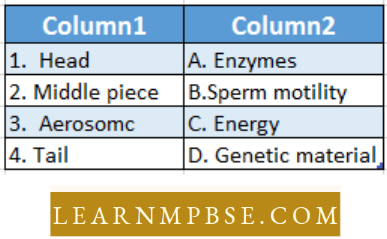
- 1 -B 2-D 3-A 4-C
- 1-D 2-C 3-A 4-B
- 1-D 2-A 3-2 4-C
- 1-B 2-A 3-C 4-D
Answer: 2. a-4 b-3 c-1 d-2
Question 49. Which among the following has 2.3 chromosomes?
- Spermatogonia
- Zygote
- Secondary oOcyte
- Ogonia
Answer: 3. Secondary oOcyte
Question 50. Match the following and choose die correct options :
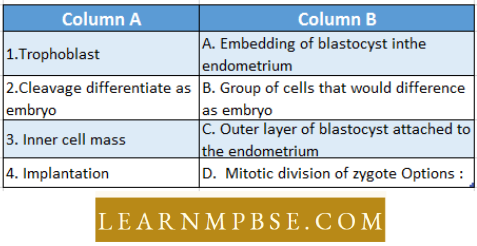
- Trophoblast 1. Embedding of blastocyst in the endometrium
- Cleavage2. Group of cells that would differentiate as embryo
- Inner cell mass 3. The outer layer of the blastocyst attached to the endometrium
- Implantation 4. Mitotic d4ision of zygote Options
Answer: 2. Cleavage2. Group of cells that would differentiate as embryo
Question 51. Which of the following hormones is not secreted by the human placenta?
- HCG
- Estrogens
- Progesterone
- LH
Answer: 4. LH
Question 52. The vas deferens receives duct from the seminal vesicle and opens into the urethra as :
- Epididymis
- Ejaculatory duct
- Efferent ductule
- Ureter
Answer: 2. Enaculatory duct
Question 53. Urethral meatus refers to the following:
- Urinogenital duct
- Labia minora
- Eimbriac
- Infundibulum
- Isthmus
Answer: 4. Infundibulum
Question 57. The method of directly injecting sperm into the ovum assisted by reproduct4e technology is called :
- GIFT
- ZIFT
- ICSI
- ET
Answer: 3. ICSI
Question 58. Increased iMR and decreased MMR in a population will:
- Cause a rapid increase in the growth rate
- Result in a decline in the growth rate
- Not cause a significant change in the growth rate
- Result in an explos4e population
Answer: 3. Not cause a significant change in growth rate
Question 59. Intensely lactating mothers do not generally conce4e due to the:
- Suppression of gonadotropins
- Hypersecretion of gonadotropin
- Suppression of gametic transport
- Suppression of fertilisation
Answer: 1. Suppression of gonadotropins
Organisms And Population MCQs NEET
Question 60. Sterilisation techniques are generally foolproof methods of contraception with least side effects. Yet, this is the last option for the couples because :
1. It is almost irreversible
2. Of the misconception that it will reduce sexual urge/ dr4e
3. It is a surgical procedure
4. Of lack of sufficient facilities in many parts of the country
Choose the correct option :
- 1 and 3
- 2 and 3
- 2 and 4
- 1, 2, 3 and 4
Answer: 4. 1, 2, 3 and 4
